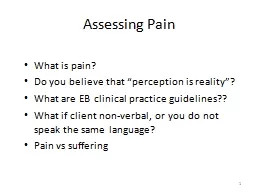PPT-Assessing Pain What is pain? Do you believe that “perception is reality”?
Author : faustina-dinatale | Published Date : 2019-11-01
Assessing Pain What is pain Do you believe that perception is reality What are EB clinical practice guidelines What if client nonverbal or you do not speak the same
Presentation Embed Code
Download Presentation
Download Presentation The PPT/PDF document "Assessing Pain What is pain? Do you beli..." is the property of its rightful owner. Permission is granted to download and print the materials on this website for personal, non-commercial use only, and to display it on your personal computer provided you do not modify the materials and that you retain all copyright notices contained in the materials. By downloading content from our website, you accept the terms of this agreement.
Assessing Pain What is pain? Do you believe that “perception is reality”?: Transcript
Download Rules Of Document
"Assessing Pain What is pain? Do you believe that “perception is reality”?"The content belongs to its owner. You may download and print it for personal use, without modification, and keep all copyright notices. By downloading, you agree to these terms.
Related Documents














